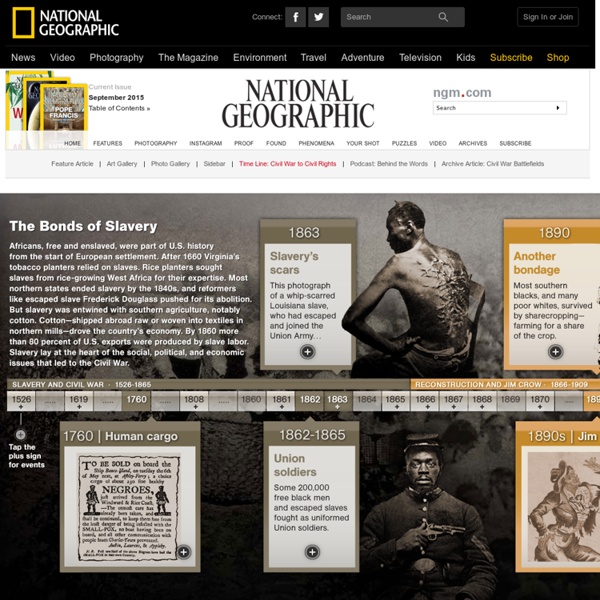



Reader Ideas | Teaching the Civil Rights Movement Jeremy M. Lange for The New York TimesThe International Civil Rights Center and Museum opened in 2010 inside a former Woolworth building in Greensboro, N.C. The store was the site of a series of luncheonette “sit-ins” against segregation beginning on Feb. 1, 1960. This month, we asked educators, How Do You Teach the Civil Rights Movement? Many echoed the findings of the Southern Poverty Law Center by writing that this era of history is little taught in their own schools and districts. Just as many educators mentioned the importance of teaching the civil rights movement in the context of African-American history as a whole, since many students bring very little background knowledge to the subject. A comment from John Padula, a Boston middle school teacher, brought together many of the points others raised: I teach grades 6, 7 and 8 in the Boston Public Schools. It’s not too late to add your own thoughts. History, Social Studies, Civics I use a Southern Poverty Law Center documentary. “Yes.”
Virksomme ord: Celebrating MLK Day Updated: Jan., 2014 In recognition of Martin Luther King Jr. Day, here is a collection of New York Times, Learning Network and other materials for teaching and learning about Dr. Selected Times Resources Historical Front Pages and Articles “Martin Luther King Wins The Nobel Prize for Peace” Oct. 15, 1962Front Page | Article (PDF)“200,000 March for Civil Rights in Orderly Washington Rally” Aug. 29, 1963Front Page | Article (PDF) “The Big Parade: On the Way to Montgomery” March 21, 1965Front Page“25,000 Go to Alabama’s Capitol” March 25, 1965Front Page“Martin Luther King is Slain in Memphis” April 4, 1968Front Page | Article (PDF) Multimedia Video Articles and Opinion Pieces Slide Show Important Moments in Black History Times Topics Learning Network Lesson Plans and Resources Text to Text | ‘I Have a Dream’ and ‘The Lasting Power of Dr. Student Crossword Puzzles Other Resources Nobelprize.org The official Nobel Prize biography of Dr.
NRK.no - Store norske Hva skjedde før og etter 7. juni 1905? Hvordan greide Norge, nærmest ved et pennestrøk, å oppløse unionen uten at Sverige gav sitt samtykke til det? I fire episoder ser Norgesglasset nærmere på året 1905 og unionsoppløsningen mellom Norge og Sverige. Av Linda Eide / Per Kristian Johansen Denne serien er en oppvarming til det store jubileumsåret 2005, og en del av startsskuddet for NRKs store serie og kåringen av den vesentligste personen som har levd i Norge i perioden 1905-2005 - den aller største norske. Unionsoppløsningen 1905 - del 1: Christian Michelsens genistrek Hvordan greide Norge, nærmest med et pennestrøk, å oppløse unionen uten at Sverige gav samtykke til det? Unionsoppløsningen 1905 - del 2: Svenskenes reaksjon på 7. juni-vedtaket Hvordan reagerte svenskene på at Christian Michelsens regjering oppløste unionen mellom Norge og Sverige i en nøye uttenkt bisetning til en bisetning? Unionsoppløsningen 1905 - del 3: Folkeavstemning, forhandlinger og krigsfare Den nye nasjonen
Freedom’s Ring: King’s “I Have a Dream” Speech Norges forsvar i middelalderen - Festningene Mennesket har gjennom alle tider forsøkt å forsvare seg mot fiender gjennom etablering av forsvarsverker. I takt med utviklingen av nye våpen og angrepsstrategier har disse utviklet seg til å bli mer og mer komplekse. Forsvarsverkene hadde også en avskrekkende funksjon i tillegg til evnen til å forsvare menneskene mot angrep. Mange steder finnes det bevart rester etter såkalte bygdeborger, med røtter tilbake til folkevandringstida (ca. 400–600). Ofte jordvoller på en høyde som i tillegg hadde pallisader eller rekker med trestokker som skulle stoppe fienden. Utover på 1100-, 1200- og 1300-tallet ble det oppført en rekke festninger eller befestede anlegg. Akershus festning, anlagt ca. 1300 ble bygget som erstatning for den befestede kongssgården i Oslo. Foto: Riksantikvaren Alf Erlingssons angrep og nedbrenning av Oslo i 1287 viste behovet for en festning i dette området. På midten av 1300-tallet kom kruttet i bruk.
Martin Luther King, Jr. Comment:Last Updated:5 September, 2014Section:Resources Martin Luther King, Jr. Martin Luther King, Jr. an American Baptist minister changed history through his non-violent approach to tackling race issues in America. Non-Violence and Civil Rights Explore issues of Non-Violent protests through key players in the Civil Rights Movement with this resource for prompting class debate. Martin Luther King, Jr. and the Christian way This presentation and worksheets explore how Martin Luther King, Jr. was compared to Jesus and how the Christian faith influenced his actions. Martin Luther King Jr.’s childhood Focus on Martin Luther King Jr.’s childhood with a role play, poetry and debating lesson. Martin Luther King, Jr. and Barack Obama Try this presentation exploring leadership qualities with a Taboo task to finish. Martin Luther King, Jr. workbook Here is a clear and simple workbook to introduce Martin Luther King, Jr. to KS1 pupils. Martin Luther King, Jr. and Racism The Race Issue in America
Rosa Parks Rosa Parks, born Rosa Louise McCauley (February 4, 1913 - October 24, 2005) was a pivotal figure in the fight for civil rights. She was a protester of segregation laws in the US, and her actions led to major reforms (changes), including a Supreme Court ruling against segregation. Arrested for Not Giving up Her Bus Seat to a White Man On December 1, 1955, a Montgomery, Alabama, bus driver ordered Mrs. Parks to give up her seat to a white man. When she refused, she was arrested and fined. Mrs. Bus Boycott Mrs. On February 1, 1956, the MIA (the Montgomery Improvement Association, which was formed after Mrs. Supreme Court Ruling On November 13, 1956, the US Supreme Court ruled that segregation on city buses is unconstitutional. Continuing the Civil Rights Movement In 1957, after receiving many death threats, Mrs. After her death, on October 24, 2005, Mrs. Related Pages: